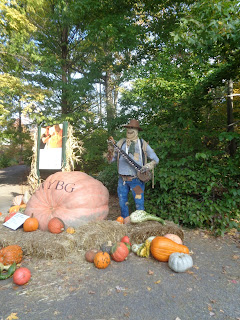In 1888 Botanists Nathaniel Lord Britton and Elizabeth Gertrude Britton visited the Royal Botanical Gardens in Kew, England and returned determined to create one of the world's great botanical gardens in New York. The 250-acre garden in the Bronx was founded in 1891 and is now not only one of the world's great botanical gardens but also an international center for plant research.
With 50 gardens and plant collections the gardens offer a constantly changing roster of visual delights for all ages.
The Everett Children's Adventure Garden gives children the chance to discover nature and explore plant science. Given the time of year the latest exhibit involved pumpkins. Lots of them!
 |
| so many shapes, sizes and colors |
 |
The largest pumpkin on display was the 2016 prize-winning pumpkin below. 2,252 lbs of pumpkin all the way from England.
A lookout over the lake provides an opportunity to spot the resident ducks, frogs and turtles.
 |
| 2016 prize-winning giant pumpkin. That's a lot of pies! |
Unfortunately on our visit the only ones visible were the ducks:
Though we were rewarded with a pleasant view:
We weren't expecting to see many flowers at this time of year so the Rockefeller Rose Garden was a delightful treat. A collection of over 2,700 roses, it was certainly past its peak, but there were still plenty of blooms to admire.
The Bronx River runs through the gardens. The Goldman Stone Mill is a reminder of the industrial use of this part of the river. Built around 1840, it is the oldest existing tobacco manufacturing building in the United States, albeit now used for staff offices and a catering venue.
A path leads from the mill alongside a gorge to a small waterfall.
Other walking trails cut through the Thain Forest, the largest remaining uncut woodland in New York City.
 |
| Native American arrowheads and pottery over 1,000 years old have been found in these rock crevices |
Our next stop was the Wild Wetland Trail where a boardwalk leads past swamp and marsh. Wetlands act as natural water filters removing debris from the water supply.
Our final stop was at the Haupt Conservatory, a stunning glass house which displays the garden's collection of plants from around the world in a series of rain-forest and desert environments.
 |
| Enid A. Haupt Conservatory |
 |
| The desert enviornment |
The museum and the conservatory feature changing exhibits and organize programs that fit with the current exhibition. On Sunday there was Taiko Drumming on the Conservatory Lawn and Saori Weaving on the Plaza to tie in with the Kiku: Art of the Japanese Garden exhibit in the Conservatory.
 |
| Kiku - Japanese Chrysanthemum |
 |
| Taiko Drumming |
We spent several hours at the Botanical Garden and saw only a fraction of what was on offer. With areas dedicated to daffodils, Azalea, Cherry Blossom and Magnolia as well as a Ladies Border and Perennial Garden, spring and summer must offer an ever-changing palette of color. In Winter an annual Holiday Train Show features model trains passing 150 landmarks built from natural materials.
It's not the first time I've been to the Botanical Gardens, but it is the first time that I've fully appreciated all it has to offer over the changing seasons. It certainly won't be my last visit.










No comments:
Post a Comment